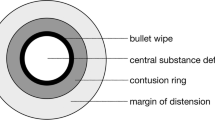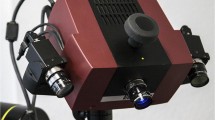Abstract
As part of a more extensive investigation of skin wounding mechanisms, we studied wounds created by five common screwdrivers (straight, star, square or Robertson, Posidriv and Phillips) on the shaven foreheads of 12 freshly slaughtered pigs. We fixed the different screwdriver heads to a 5-kg metal cylinder which was directed vertically onto each pig head by a droptube of 700 mm length. We examined skin lesions by photography and also by scanning electron microscopy (SEM). Our evaluation of differences in wound shape and size was based on geometric morphometric methods. Our results show that there are obvious morphological differences between the straight head and the other types. The straight-headed screwdriver penetrates the skin by a mode II crack which results in a compressed skin plug with bundles of collagen fibres forming skin tabs within the actual wound. The sharper-tipped screwdrivers wedge open the skin (mode I), with a clearly defined edge with no skin plugs. Geometric morphometric analysis indicates that shapes of skin wounds created by the five screwdriver types could be classified into three different groups. The straight head results in the most differentiated wound profile, with the Robertson or square and some specimens of star, and also the Posidriv and Phillips giving similar wound outlines. SEM evaluation of wounds created by a new and worn straight-head screwdrivers shows that the outline of the worn screwdriver head is reflected in the shape of the wound it created.










Similar content being viewed by others
References
Khalil N, Elwany MN, Miller JD (1991) Transcranial stab wounds: morbidity and medicolegal awareness. Surg Neurol 35:294–296
Nadjem H, Pollack S (1993) Manifestations of screwdriver injuries. Arch Kriminol 192:27–36
Smrkolj V, Balazic J, Princic J (1995) Intracranial injuries by a screwdriver. Forensic Sci Int 76:211–216
Evans RJ, Richmond JM (1996) An unusual death due to screwdriver impalement. Am J Forensic Med Pathol 17:70–72
Yang KH (2003) Removal of broken tip of hexagonal screwdriver from nail end cap using a magnetic bar. J Orthop Trauma 17:642–643
Wong SCK, Duke T, Evans PA (2002) Penetrating injury of the temporal fossa with a screwdriver with associated traumatic optic neuropathy. J Trauma 52:1189–1191
Trutton MG, Chitnavis B, Stell IM (2000) Screwdriver assaults and intracranial injuries. J Accid Emerg Med 17:225–226
Rawson BR, Starich GH, Rawson R (2000) Scanning electron microscopic analysis of skin resolution as an aid in identifying trauma in forensic investigations. J Forensic Sci 45:1023–1027
Fracasso T, Karger B (2006) Two unusual stab injuries to the neck: homicide or self-infliction. Int J Legal Med 120:369–371
Sitiene R, Zakaras A, Pauliukkevicius A, Kisielius G (2004) Morphologic, experimental-comparative investigation as an identification of the injurying instrument method. Forensic Sci Int 146:S59–S60
Rao VJ, Hart R (1983) Tool marks in cartilage of stabbing victim. J Forensic Sci 28:794–799
Houck MM (1998) Skeletal trauma and the individualization of knife marks in bones. In: Reichs KJ (ed) Forensic osteology: advances in the identification of human remains. 2nd edn. Charles Thomas, Illinois, pp 410–424
Bartelink EJ, Wiersema JM, Demaree RS (2001) Quantitative analysis of sharp-force trauma: an application of scanning electron microscopy in forensic anthropology. J Forensic Sci 46:1288–1293
Alunni-Perret V, Muller-Bolla M, Laugier JP et al (2005) Scanning electron microscopy analysis of experimental bone hacking trauma. J Forensic Sci 50:796–801
Brinkmann B, Kleiber M (1978) Zur Morphologie von Schraubenzieher-Stichverletzungen. Arch Kriminol 161:31–40
Dadour IR, Cook DF, Fissidi JN, Bailey WJ (2001) Forensic entomology: application, education and research in Western Australia. Forensic Sci Int 120:48–52
Forbes SL, Dent BB, Stuart BH (2002) The effect of soil type on the formation of adipocere in grave soil. Forensic Sci Int 127:225–230
Rohlf FJ (2006) tps serie software. Available at http://life.bio.sunysb.edu/morph/
Bookstein FL (1991) Morphometric tools for landmark data: geometry and biology. Cambridge University Press, Cambridge
Gower JC (1975) Generalized Procrustes analysis. Psychometrika 40:33–51
Rohlf FJ, Slice DE (1990) Extensions of the Procrustes method for the optimal superimposition of landmarks. Syst Zool 39:40–59
Bookstein FL (1997) Landmark methods for forms without landmarks: localizing group differences in outline shape. Med Image Anal 1:225–243
Perez SI, Bernal V, Gonzalez PN (2006) Differences between sliding semi-landmark methods in geometric morphometrics, with an application to human craniofacial and dental variation. J Anat 208:769–784
Adams DC, Rohlf FJ, Slice DE (2004) Geometric morphometrics: ten years of progress following the ‘revolution’. Ital J Zool 71:5–16
Bookstein FL, Streissguth AP, Sampson PD, Connor PD, Barr HM (2002) Corpus callosum shape and neuropsychological deficits in adult males with heavy fetal alcohol exposure. Neuroimage 15:233–251
Sheets HD (2003) IMP-integrated morphometrics package. Department of Physics, Canisius College, Buffalo, NY
Sampson PD, Bookstein FL, Sheehan H, Bolson EL (1996) Eigenshape analysis of left ventricular outlines from contrast ventriculograms. In: Marcus LF, Corti M, Loy A, Naylor GJP, Slice DE (eds) Advances in morphometrics. Nato ASI Series, Series A: Life Science, vol. 284. Plenum, New York, pp 131–152
Bookstein FL (1996) Combining the tools of geometric morphometrics. In: Marcus LF, Corti M, Loy A, Naylor GJP, Slice DE (eds) Advances in morphometrics. Nato ASI Series, Series A: Life Science, Vol. 284. Plenum, New York, pp 131–152
Rohlf FJ (1993) Relative warps analysis and an example of its application to mosquito wings. In: Marcus LF, Bello E, García-Valdecasas A (eds) Contributions to morphometrics. Monografías del Museo Nacional de Ciencias Naturales, Madrid, pp 132–159
Bookstein FL (1989) Principal warps: thin-plate splines and the decomposition of deformations. IEEE Trans Pattern Anal Mach Intell 11:67–585
Bookstein FL (1996) A standard formula for the uniform shape component in landmark data. In advances in morphometrics. In: Marcus LF, Corti M, Loy A, Naylor GJP, Slice DE (eds) Advances in morphometrics. Nato ASI Series, Series A: Life Science, vol. 284. Plenum, New York, pp 153–168
Rohlf FJ, Bookstein FL (2003) Computing the uniform component of shape variation. Syst Biol 52:66–69
Foote M (1993) Contributions of individual taxa to overall morphological disparity. Paleobiology 19:403–419
Doran CF, McCormack BA, Macey A (2004) A simplified model to determine the contribution of strain energy in the failure process of thin biological membranes during cutting. Strain 40:173–179
Kieser JA, Whittle K, Wong B, Waddell JN, Ichim I, Swain M, Taylor M, Nicholson H (2007) Understanding craniofacial blunt force injury: a biomechanical perspective. Forens Path Rev 4 (in press)
Shergold OA, Fleck NA (2004) Mechanisms of deep penetration of soft solids, with application to the injection and wounding of skin. Proc R Soc Lond A Math Phys Eng Sci 460:3037–3058
Author information
Authors and Affiliations
Corresponding author
Rights and permissions
About this article
Cite this article
Kieser, J., Bernal, V., Gonzalez, P. et al. Analysis of experimental cranial skin wounding from screwdriver trauma. Int J Legal Med 122, 179–187 (2008). https://doi.org/10.1007/s00414-007-0187-1
Received:
Accepted:
Published:
Issue Date:
DOI: https://doi.org/10.1007/s00414-007-0187-1




